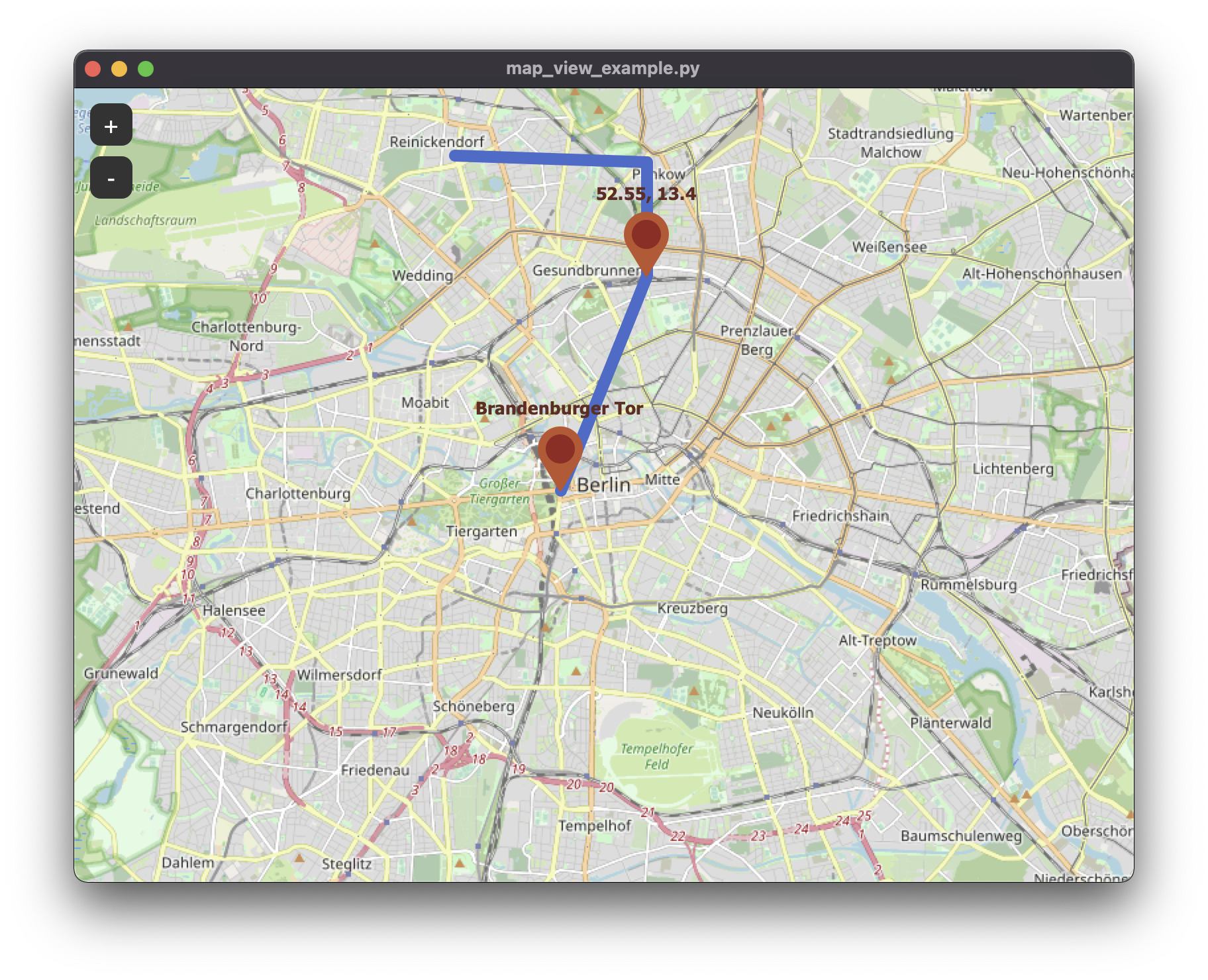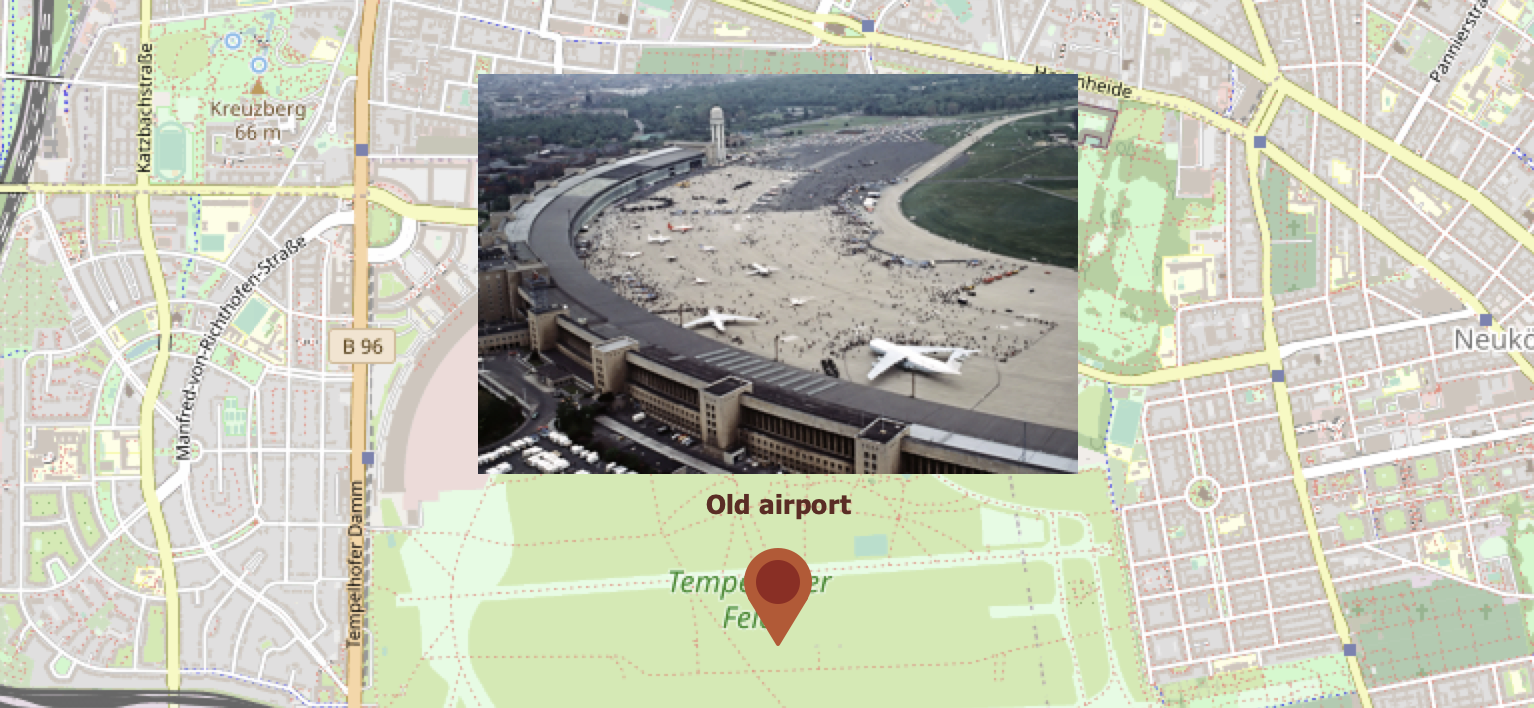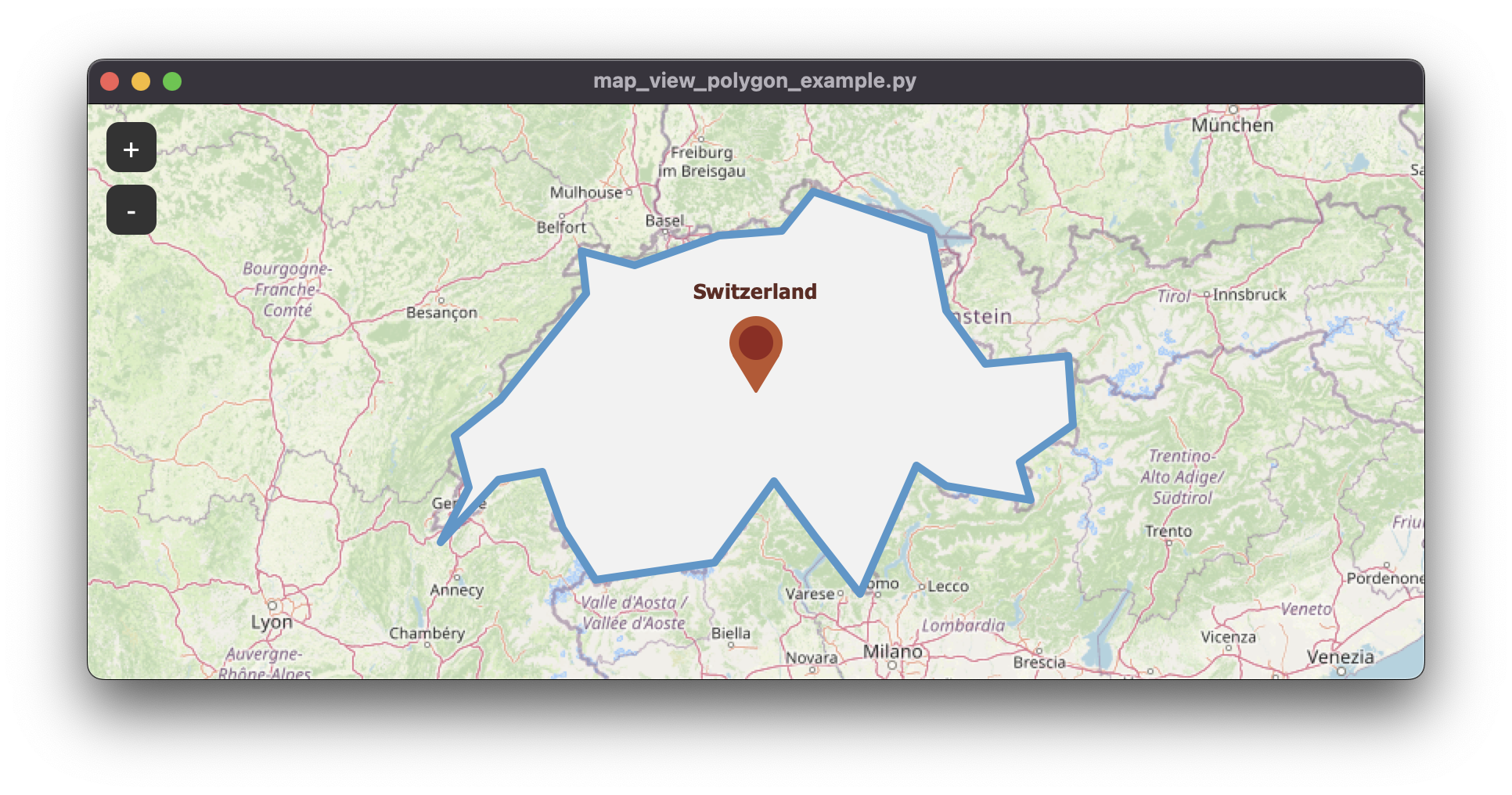TkinterMapView is a tile based interactive map renderer widget for the python Tkinter library. By default, it displays the OpenStreetMap map, but you can change the tile server to whatever you like, and it also supports a second tile server for overlays like OpenSeaMap. You can set the current focus of the widget by a position or address, and place markers or a path on the map.
The above image program is produced by the code example map_view_simple_example.py.
But you can also embed the widget into a program like the following image shows. For example by using the CustomTkinter library, which provides rounded buttons and frames in a light and dark mode:
tkintermapview_macos.mp4
|examples/map_with_customtkinter.py on macOS
pip3 install tkintermapview
Update: pip3 install tkintermapview --upgrade
https://pypi.org/project/tkintermapview/
- Importing
- Create the widget
- Set coordinate position
- Set address position
- Set position with marker
- Set position and zoom to fit bounding box
- Create position markers
- Create path from position list
- Create polygon from position list
- Mouse events on the map
- Utility methods
- Use other tile servers
- Use offline tiles
Import tkinter as normal and from tkintermapview import the TkinterMapView widget.
import tkinter
import tkintermapviewCreate the standard tkinter window and place a TkinterMapView in the middle of the window.
The first argument must be the widgets master, then you specify the width, height and corner_radius
of the widget.
# create tkinter window
root_tk = tkinter.Tk()
root_tk.geometry(f"{800}x{600}")
root_tk.title("map_view_example.py")
# create map widget
map_widget = tkintermapview.TkinterMapView(root_tk, width=800, height=600, corner_radius=0)
map_widget.place(relx=0.5, rely=0.5, anchor=tkinter.CENTER)If you also call root_tk.mainloop() at the end, this is already a fully working example to test the map widget.
The standard position on which the map is focused is Berlin, Germany, but you can change the position and zoom with the following commands. The position must be given in decimal coordinates and the zoom ranges from 0 to 19 where 19 is the highest zoom level.
# set current widget position and zoom
map_widget.set_position(48.860381, 2.338594) # Paris, France
map_widget.set_zoom(15)But you can not only set the position by decimal coordinates, but also by
an address string like "colosseo, rome, italy" or "3 St Margaret St, London, United Kingdom".
The address is converted to a position by the OpenStreetMap geocode service
Nomatim.
# set current widget position by address
map_widget.set_address("colosseo, rome, italy")If you also want a red marker at the set position with a text of the current location,
then you can pass the marker=True argument to the set_position or set_address
funtions. You get back a PositionMarker object, so that you can modify or delete the marker
later:
# set current widget position by address
marker_1 = map_widget.set_address("colosseo, rome, italy", marker=True)
print(marker_1.position, marker_1.text) # get position and text
marker_1.set_text("Colosseo in Rome") # set new text
# marker_1.set_position(48.860381, 2.338594) # change position
# marker_1.delete()If you have two decimal coordinates (, ) and (, ), that define a box, so that the first coordinate is the top-left corner and the second coordinate is the bottom-right corner. Then you can use the fit_bounding_box method of the map widget to fit this box into the map widget:
map_widget.fit_bounding_box((<lat1>, <long1>), (<lat2>, <long2>))You can also set a position marker without focusing the widget on it.
You can pass a text argument to the function and get back the marker
object, so that you can store the marker and modify or delete it later.
# set a position marker
marker_2 = map_widget.set_marker(52.516268, 13.377695, text="Brandenburger Tor")
marker_3 = map_widget.set_marker(52.55, 13.4, text="52.55, 13.4")
# methods
marker_3.set_position(...)
marker_3.set_text(...)
marker_3.change_icon(new_icon)
marker_3.hide_image(True) # or False
marker_3.delete()A marker can be also customized by passing the following arguments to .set_marker(),
.set_address() or .set_position(): text, font, icon, icon_anchor, image (PhotoImage), image_zoom_visibility, marker_color_circle, marker_color_outside, text_color, command.
The command function will be called when the marker is clicked and will pass the clicked marker as an argument to the functin which gets called.
The given image will be visible above the marker when the zoom level is in the range specified
by image_zoom_visibility, which is tuple like the following (min_zoom, max_zoom).
image_zoom_visibility=(0, float('inf')) means the image will be visible alle the time.
The image can also be hidden by calling: marker.hide_image(True) or marker.hide_image(False).
To check if the image is currently hidden you can access: marker.image_hidden which is True or False.
You can also store an object or some reference inside the marker with the data attribute, which
can be set when creating a marker, and accessed or modified with marker.data. This data attribute
also exists for path and polygons.
With the icon attribute you can pass a PIL.ImageTk.PhotoImage object to a marker, which will be
displayed instead of the standard location icon. With icon_anchor you can specify the anchor
for the icon image (center, n, nw, w, sw, s, ew, e, ne), corresponding to the position of the marker, standard is center, where the icon
image is centered over the marker position. With the .change_icon(new_icon) method you can change
the icon image later, but only if the marker already has an icon image from the beginning.
In examples/map_view_marker_icon_images.py you can find example code for the icon attributes.
With map_widget.delete_all_marker() all marker on the map will be deleted.
You can also create a path which connects multiple markers or completely new positions.
You pass a list with position tuples to the function set_path and get back a path object.
The path object can be modified by adding a new position or remove a specific position.
The set_path method accepts the following arguments: position_list, color, command (on click),
name (string for identification), width, `data (anything can be stored in the path object).
# set a path
path_1 = map_widget.set_path([marker_2.position, marker_3.position, (52.57, 13.4), (52.55, 13.35)])
# methods
path_1.set_position_list(new_position_list)
path_1.add_position(position)
path_1.remove_position(position)
path_1.delete()With map_widget.delete_all_path() all path on the map will be deleted.
To create a polygon on the map call the map_widget.set_polygon() function
and pass a list of coordinate tuples from which the polygon will be created.
You can edit the appearance with the following arguments: fill_color, outline_color, border_width.
You can also set a command function which will be called when the polygon gets clicked and
which will get the polygon object as an argument.
def polygon_click(polygon):
print(f"polygon clicked - text: {polygon.name}")
polygon_1 = map_widget.set_polygon([(46.0732306, 6.0095215),
...
(46.3772542, 6.4160156)],
# fill_color=None,
# outline_color="red",
# border_width=12,
command=polygon_click,
name="switzerland_polygon")
# methods
polygon_1.remove_position(46.3772542, 6.4160156)
polygon_1.add_position(0, 0, index=5)
polygon_1.delete()In examples/map_view_polygon_example.py you can find the full example program,
which results in the following:
With map_widget.delete_all_polygon() all polygons on the map will be deleted.
When you click on the map with the right mouse button, a menu pops up, where you can view the
current decimal coordinates and copy them into the clipboard by clicking them.
You can also add other options to this menu, with the map_widget.add_right_click_menu_command method:
def add_marker_event(coords):
print("Add marker:", coords)
new_marker = map_widget.set_marker(coords[0], coords[1], text="new marker")
map_widget.add_right_click_menu_command(label="Add Marker",
command=add_marker_event,
pass_coords=True)With the label argument you set the text inside the menu, and if pass_coords
is True, the clicked coordinates will be passed to the command function as a tuple.
You can also assign a callback function for a left click event on the map with:
def left_click_event(coordinates_tuple):
print("Left click event with coordinates:", coordinates_tuple)
map_widget.add_left_click_map_command(left_click_event)The callback function will get the decimal coordinates of the clicked location as a tuple.
The following methods can be useful when working with coordinates and address strings, they all use the geocoder library with the OSM provider: https://geocoder.readthedocs.io/providers/OpenStreetMap.html:
Convert decimal coords to address object:
adr = tkintermapview.convert_coordinates_to_address(51.5122057, -0.0994014)
print(adr.street, adr.housenumber, adr.postal, adr.city, adr.state, adr.country, adr.latlng)
# Output: Knightrider Street None EC4 City of London England United Kingdom [51.512284050000005, -0.09981746110011651]Convert decimal coords to city name:
city = tkintermapview.convert_coordinates_to_city(51.5122057, -0.0994014)
# city: "City of London"Convert decimal coords to country name:
country = tkintermapview.convert_coordinates_to_city(51.5122057, -0.0994014)
# country: "United Kingdom"Convert address string to decimal coords. If the address isn't found, the function returns None.
address = tkintermapview.convert_address_to_coordinates("London")
# address: (51.5073219, -0.1276474)TkinterMapView uses OpenStreetMap tiles by default, but you can also change the
tile server to every url that includes {x} {y} {z} coordinates.
For example, you can use the standard Google Maps map style or Google Maps
satellite images:
# example tile sever:
self.map_widget.set_tile_server("https://a.tile.openstreetmap.org/{z}/{x}/{y}.png") # OpenStreetMap (default)
self.map_widget.set_tile_server("https://mt0.google.com/vt/lyrs=m&hl=en&x={x}&y={y}&z={z}&s=Ga", max_zoom=22) # google normal
self.map_widget.set_tile_server("https://mt0.google.com/vt/lyrs=s&hl=en&x={x}&y={y}&z={z}&s=Ga", max_zoom=22) # google satellite
self.map_widget.set_tile_server("http://c.tile.stamen.com/watercolor/{z}/{x}/{y}.png") # painting style
self.map_widget.set_tile_server("http://a.tile.stamen.com/toner/{z}/{x}/{y}.png") # black and white
self.map_widget.set_tile_server("https://tiles.wmflabs.org/hikebike/{z}/{x}/{y}.png") # detailed hiking
self.map_widget.set_tile_server("https://tiles.wmflabs.org/osm-no-labels/{z}/{x}/{y}.png") # no labels
self.map_widget.set_tile_server("https://wmts.geo.admin.ch/1.0.0/ch.swisstopo.pixelkarte-farbe/default/current/3857/{z}/{x}/{y}.jpeg") # swisstopo map
# example overlay tile server
self.map_widget.set_overlay_tile_server("http://tiles.openseamap.org/seamark//{z}/{x}/{y}.png") # sea-map overlay
self.map_widget.set_overlay_tile_server("http://a.tiles.openrailwaymap.org/standard/{z}/{x}/{y}.png") # railway infrastructureYou can load tiles into a database to use them offline when there is no connection to the tile server. Check out examples/load_offline_tiles.py for more information.
If you then create the TkinterMapView widget you pass the database path as an argument. An example of this can be found here: examples/map_with_offline_tiles.py You can also pass a max_zoom argument to limit the possible zoom range if the database just holds the tiles until a specific zoom range which is not the limit of the used server.






